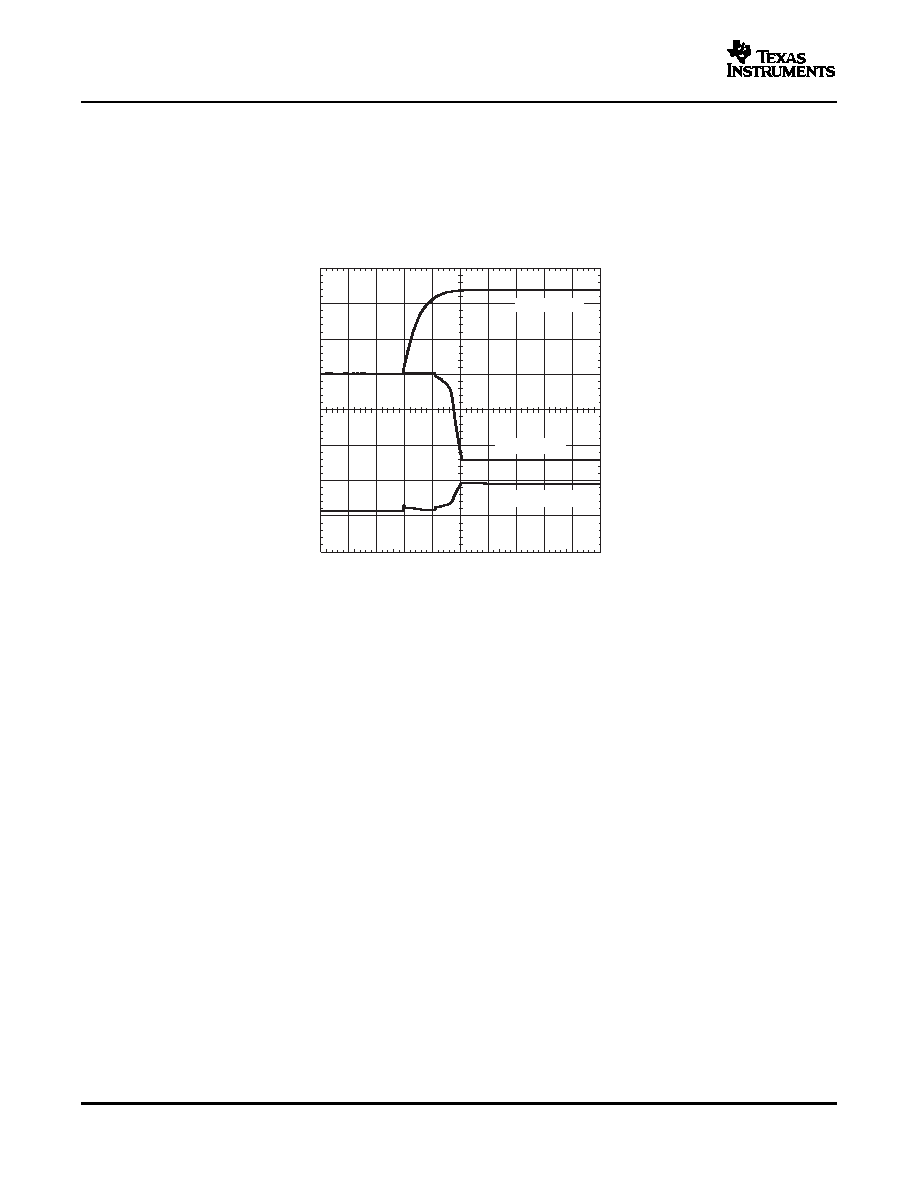- 您現(xiàn)在的位置:買賣IC網(wǎng) > PDF目錄69257 > PTN78060AAST (TEXAS INSTRUMENTS INC) 1-OUTPUT 15 W DC-DC REG PWR SUPPLY MODULE PDF資料下載
參數(shù)資料
| 型號(hào): | PTN78060AAST |
| 廠商: | TEXAS INSTRUMENTS INC |
| 元件分類: | 電源模塊 |
| 英文描述: | 1-OUTPUT 15 W DC-DC REG PWR SUPPLY MODULE |
| 封裝: | DIP-7 |
| 文件頁數(shù): | 4/19頁 |
| 文件大?。?/td> | 589K |
| 代理商: | PTN78060AAST |

www.ti.com
Power-Up Characteristics
VI (5V/div)
VO (2V/div)
II (2 A/div)
t-Time=5ms/div
Undervoltage Lockout
Current Limit Protection
Overtemperature Protection
SLTS245B – APRIL 2005 – REVISED AUGUST 2006
When configured per the standard application, the PTN78060A power module produces a regulated output
voltage following the application of a valid input source voltage. During power up, internal soft-start circuitry
slows the rate that the output voltage rises, thereby limiting the amount of in-rush current that can be drawn from
the input source. The soft-start circuitry introduces a short time delay (typically 5 ms – 10 ms) into the power-up
characteristic. This is from the point that a valid input source is recognized. Figure 19 shows the power-up
waveforms when operating from a 12-V input and with the output voltage adjusted to –5-V. The waveforms were
measured with a 2.8-A resistive load.
Figure 19. Power-Up Waveforms
The undervoltage lockout (UVLO) circuit prevents the module from attempting to power up until the input voltage
is above the UVLO threshold. This is to prevent the module from drawing excessive current from the input
source at power up. Below the UVLO threshold, the module is held off.
The module is protected against load faults with a continuous current limit characteristic. Under a load-fault
current limit threshold causes the module to progressively reduce its output voltage. Current is continuously
supplied to the fault until the fault is removed. Once it is removed, the output voltage promptly recovers. When
limiting output current, the regulator experiences higher power dissipation, which increases its temperature. If
the temperature increase is excessive, the module's overtemperature protection begins to periodically turn the
output voltage off.
A thermal shutdown mechanism protects the module's internal circuitry against excessively high temperatures. A
rise in temperature may be the result of a drop in airflow, a high ambient temperature, or a sustained current
limit condition. If the internal temperature rises excessively, the module turns itself off, reducing the output
voltage to zero. The module exercises a soft-start power up when the sensed temperature has decreased by
about 10°C below the trip point.
NOTE: Overtemperature protection is a last-resort mechanism to prevent damage to the module. It should not
be relied on as permanent protection against thermal stress. Always operate the module within its temperature
derated limits, for the worst-case operating conditions of output current, ambient temperature, and airflow.
Operating the module above these limits, albeit below the thermal shutdown temperature, reduces the long-term
reliability of the module.
12
相關(guān)PDF資料 |
PDF描述 |
|---|---|
| PTN78060AAZT | 1-OUTPUT 15 W DC-DC REG PWR SUPPLY MODULE |
| PTN78060AAH | 1-OUTPUT 15 W DC-DC REG PWR SUPPLY MODULE |
| PTN78060WAZT | 1-OUTPUT 45 W DC-DC REG PWR SUPPLY MODULE |
| PTN78060HAST | 1-OUTPUT 45 W DC-DC REG PWR SUPPLY MODULE |
| PTN78060HAH | 1-OUTPUT 45 W DC-DC REG PWR SUPPLY MODULE |
相關(guān)代理商/技術(shù)參數(shù) |
參數(shù)描述 |
|---|---|
| PTN78060AAS-T | 制造商:TI 制造商全稱:Texas Instruments 功能描述:15-W, WIDE-INPUT ADJUSTABLE POSITIVE-TO-NEGATIVE VOLTAGE REGULATOR MODULE |
| PTN78060AAZ | 功能描述:DC/DC轉(zhuǎn)換器 3A Wide-In Wide Neg Out Adj Module RoHS:否 制造商:Murata 產(chǎn)品: 輸出功率: 輸入電壓范圍:3.6 V to 5.5 V 輸入電壓(標(biāo)稱): 輸出端數(shù)量:1 輸出電壓(通道 1):3.3 V 輸出電流(通道 1):600 mA 輸出電壓(通道 2): 輸出電流(通道 2): 安裝風(fēng)格:SMD/SMT 封裝 / 箱體尺寸: |
| PTN78060AAZT | 功能描述:DC/DC轉(zhuǎn)換器 3A Wide-In Wide Neg Out Adj Module RoHS:否 制造商:Murata 產(chǎn)品: 輸出功率: 輸入電壓范圍:3.6 V to 5.5 V 輸入電壓(標(biāo)稱): 輸出端數(shù)量:1 輸出電壓(通道 1):3.3 V 輸出電流(通道 1):600 mA 輸出電壓(通道 2): 輸出電流(通道 2): 安裝風(fēng)格:SMD/SMT 封裝 / 箱體尺寸: |
| PTN78060AAZ-T | 制造商:TI 制造商全稱:Texas Instruments 功能描述:15-W, WIDE-INPUT ADJUSTABLE POSITIVE-TO-NEGATIVE VOLTAGE REGULATOR MODULE |
| PTN78060H | 制造商:TI 制造商全稱:Texas Instruments 功能描述:3-A, WIDE-INPUT ADJUSTABLE SWITCHING REGULATOR |
發(fā)布緊急采購,3分鐘左右您將得到回復(fù)。